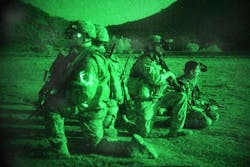Researchers seek to develop uncooled longwave infrared imaging sensors for high-resolution surveillance
ARLINGTON, Va. – U.S. military researchers are asking industry to develop uncooled longwave infrared imaging sensors for applications like security, surveillance, industrial monitoring, and autonomous vehicle navigation.
Officials of the U.S. Defense Advanced Research Projects Agency (DARPA) in Arlington, Va., a Small Business Innovation Research (SBIR) and Small Business Technology Transfer (STTR) opportunity on Tuesday for the Extreme Photon Imaging Capability-Long Wave Infrared (EPIC-LWIR) project.
Developmental infrared sensors resulting from this project should be based on advanced nanocrystalline materials with low noise equivalent difference temperature (NEDT), high pixel density, and frame rates exceeding those of typical microbolometers.
Sensors developed should have noise equivalent difference temperature of less than 20 microKelvin; pixel sizes smaller than 20 microns; offer resolutions of 2,048 by 2,048 pixels or better; and frame rates of at least 120 Hz.
Related: Army considers upgrading night-vision sensors with mid- and long-wave IR imaging components
Nanocrystalline and low dimensional materials such as quantum dots have gained substantial interest because of their desirable properties like tunable bandgap energies, quantum confinement, multi-exciton generation, and phonon quenching, DARPA researchers explain.
Such materials hold promise as high-performance photon absorbers operating at room temperature and can be tailored to the longwave infrared region of the electromagnetic spectrum where many applications of interest exist.
In addition, these materials often are amenable to solution processing techniques that could lead to low-cost imagers with small pixel sizes while avoiding hybridization with silicon-based complementary metal oxide semiconductors or other forms of readout circuitry.
Yet many challenges remain in using such materials to produce practical devices such as poor charge transport, high dark currents, limited scalability of assembly processes, limited lifetimes, or poor stability.
DARPA researchers want industry to develop materials and processes culminating in the production of Technology Readiness Level (TRL) 5 prototype devices and the generation of test object images. TRL-5 refers to developmental technologies.
The project's first phase will last for six months, and will demonstrate the feasibility of the technology. The second phase will last for three years and will produce a developmental prototype. the third phase, if pursued, will involve technology applications in security, autonomous systems, safety, energy conservation, and equipment monitoring.
Companies interested should submit 20-page phase-one proposals no later than 20 April 2021 to the DoD SBIR/STTR Proposal Submission website at www.dodsbirsttr.mil/submissions. Email questions or concerns to DARPA at [email protected], with BAA HR001121S0007-04 in the subject line.
More information is online at https://beta.sam.gov/opp/ad4182d8822149858e69c2706f819273/view.

John Keller | Editor-in-Chief
John Keller is the Editor-in-Chief, Military & Aerospace Electronics Magazine--provides extensive coverage and analysis of enabling electronics and optoelectronic technologies in military, space and commercial aviation applications. John has been a member of the Military & Aerospace Electronics staff since 1989 and chief editor since 1995.

